Welcome to the Email Deliverability Guide!
If you’re an email marketer, marketing professional, B2B salesperson, or business professional looking to maximize the effectiveness of your email campaigns, you’re in for a treat.
- What Is Email Deliverability?
- Email Deliverability vs. Email Delivery
- Why Is Email Deliverability Important?
- 11 Ways to Improve Email Deliverability
- 1. Build a High-Quality Email List
- 2. Authenticate Your Emails
- 3. Optimize Email Design and Content
- 4. Monitor and Manage Your Sender Reputation
- 5. Segment Your Email List
- 6. Optimize Send Frequency and Timing
- 7. Test and Optimize Email Deliverability
- 8. Maintain List Hygiene
- 9. Monitor Engagement Metrics
- 10. Provide Clear Unsubscribe Options
- 11. Tools for Email Deliverability
- 6 Ways to Avoid Sending Spam Email
- 1. Obtain Permission to Send Emails
- 2. Comply With Anti-Spam Laws
- 3. Use a Reputable Email Service Provider (ESP)
- 4. Regularly Cleanse and Segment Your Email List
- 5. Avoid Misleading Subject Lines and Content
- 6. Monitor Blacklists and Feedback Loops
Email deliverability is a critical factor that can make or break the success of your email marketing efforts. In an era where inboxes are inundated with countless messages, standing out and connecting with your audience requires a strategic approach.
By mastering the art of email deliverability, you can overcome spam filters, maintain a stellar sender reputation, and craft compelling emails that resonate with your subscribers.
In this guide, we’ll dive deep into the email deliverability world, providing valuable email deliverability tips, insights, and best practices to ensure your emails reach the intended recipients and engage them effectively.
So, get ready to unlock the secrets of email deliverability, elevate your email marketing game, and watch your campaigns flourish with increased engagement and conversions.
Read also: Reasons Why Your Email Campaigns Fail
What Is Email Deliverability?
Email deliverability is the ability of an email to reach the recipient’s inbox successfully. It involves various factors, such as avoiding spam filters, maintaining a good sender reputation, and optimizing email content to ensure high inbox placement rates. In simpler terms, it’s about ensuring your emails get delivered to the people you’re sending them to.
Email Deliverability vs. Email Delivery
The terms “email delivery” and “email deliverability” are often used interchangeably. However, it’s important to understand the subtle yet significant differences between the two concepts.
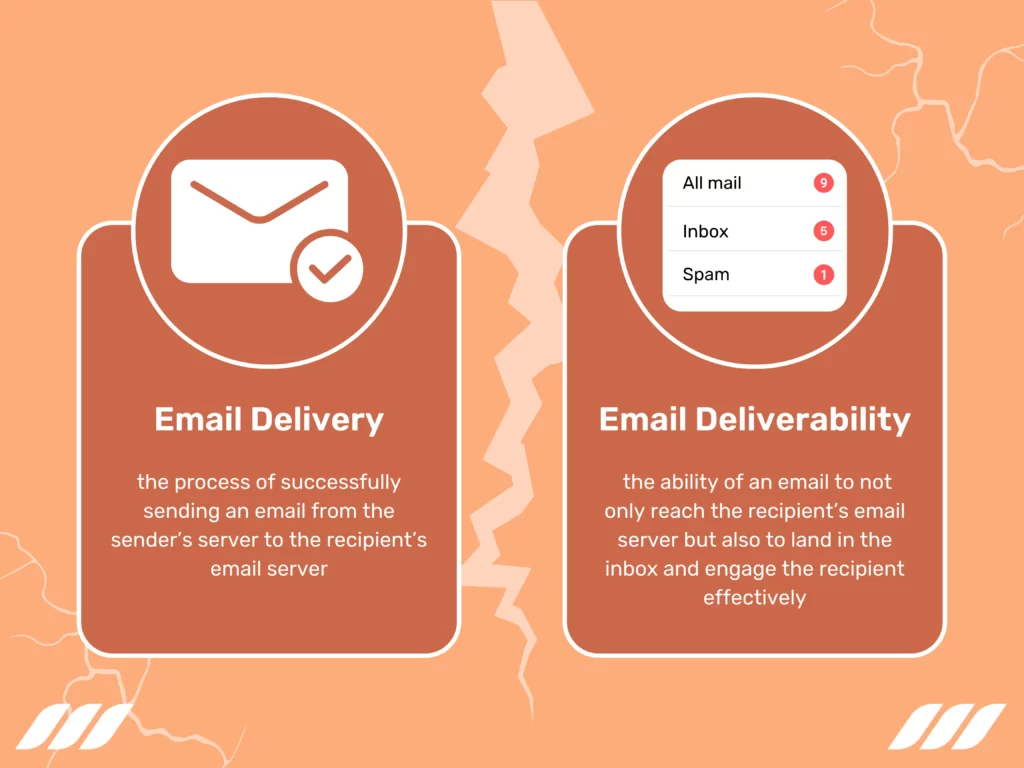
Email Delivery: The Journey from Sender to Recipient’s Server
Email delivery refers to the process of successfully sending an email from the sender’s server to the recipient’s email server. It involves the technical aspects of transmitting the email across the vast expanse of the internet, traversing multiple servers and networks until it reaches its destination.
During the email delivery process, several factors come into play. These include the proper configuration of the sender’s email server, adherence to email protocols, and the ability to connect with the recipient’s email server. Email delivery focuses on successfully transmitting the email, ensuring it arrives at the recipient’s server without being lost or bounced back.
Email Deliverability: Reaching the Inbox and Engaging the Recipient
While email delivery deals with the technical aspect of transmitting emails, email deliverability encompasses a broader scope. It revolves around the ability of an email to not only reach the recipient’s email server but also to land in the inbox and engage the recipient effectively.
Email deliverability involves an interplay of various factors that determine whether an email ends up in the inbox or gets flagged as spam. These factors include the sender’s reputation, email content, authentication protocols, spam filters, recipient engagement, and more.
In essence, email deliverability goes beyond the successful transmission of an email; it focuses on ensuring that the email reaches the intended recipient’s inbox, avoids being marked as spam, and captures the recipient’s attention. It encompasses the entire journey of an email, from its initial sending to its successful placement in the recipient’s inbox.
Read also: Cold Email Myths
Why Is Email Deliverability Important?
Email deliverability plays a vital role in the success of your email campaigns. Poor deliverability can significantly impact your marketing efforts, resulting in lower open rates, reduced engagement, and decreased conversions.
By focusing on improving email deliverability, you can enhance the effectiveness of your campaigns, build stronger customer relationships, and drive better results. Here are a few key reasons why it is crucial to prioritize and improve your email deliverability:
- Maximize Reach and Engagement: Ensuring high email deliverability allows your messages to reach the intended recipients’ inboxes. By bypassing spam filters and landing directly in the inbox, you increase the chances of your subscribers actually seeing and engaging with your emails. This leads to higher open rates, click-through rates, and, ultimately, more conversions.
- Strengthen Customer Relationships: When your emails consistently reach the inbox, you build trust and credibility with your subscribers. By delivering relevant, valuable, and engaging content, you establish yourself as a reliable source of information and maintain strong relationships with your audience. This enhances brand loyalty and encourages continued engagement with your email campaigns.
- Drive Conversions and Revenue: Improved email deliverability translates to higher engagement rates, directly impacting your conversion rates and revenue generation.
Engaged subscribers will likely take desired actions, such as making purchases, signing up for services, or attending events. By reaching the inbox consistently and delivering compelling content, you maximize the potential for conversions and revenue growth.
- Optimize Marketing ROI: Email marketing is a cost-effective strategy with a high return on investment (ROI). However, if your emails are not reaching the intended recipients, your marketing efforts go to waste. When you focus on email deliverability, you ensure that your resources are utilized effectively, maximizing the ROI of your email marketing campaigns.
- Maintain Sender Reputation: Email deliverability is closely tied to your sender reputation. ISPs and spam filters evaluate the reputation of email senders to determine whether to deliver their messages to the inbox or divert them to the spam folder.
This means by maintaining a positive sender reputation through good email deliverability practices, and you can increase the chances of your future emails landing in the inbox and avoid damaging your reputation.
- Comply With Regulations: Email deliverability is intricately linked to compliance with anti-spam laws and regulations. Following the best practices and avoiding spammy tactics ensures that your email campaigns align with legal requirements. This will help you avoid penalties and legal issues while maintaining ethical email marketing practices.
11 Ways to Improve Email Deliverability
Now that you know the importance of email deliverability, let’s explore email deliverability tips to boost your campaign’s performance. So, get ready to take inspiration and implement these best practices for your email campaigns.
1. Build a High-Quality Email List
First things first, prioritize quality over quantity when building your email list for marketing. Make sure to get explicit permission from subscribers to ensure they genuinely want to receive your emails. Also, avoid purchasing or renting email lists, as they often contain outdated or unengaged contacts.
A high-quality email list consists of engaged subscribers who are more likely to open, click, and convert. It is a good idea to implement a double opt-in process where subscribers confirm their email addresses to ensure accurate and active contacts.
2. Authenticate Your Emails
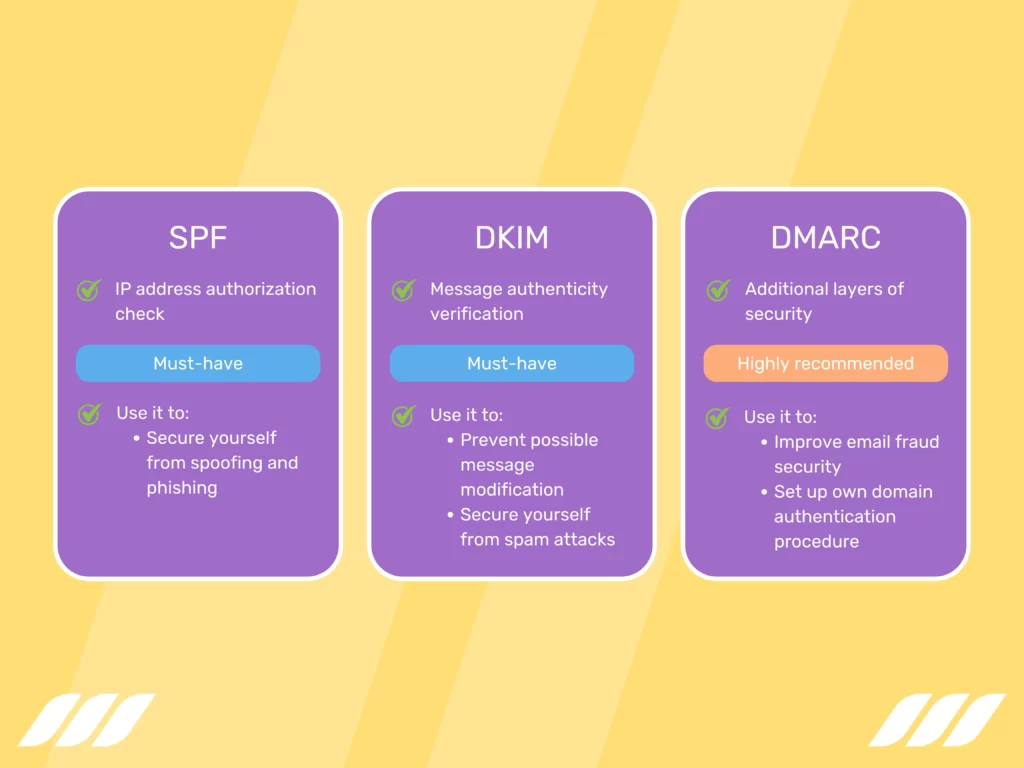
Next, make sure to implement email authentication protocols like SPF (Sender Policy Framework), DKIM (DomainKeys Identified Mail), and DMARC (Domain-based Message Authentication, Reporting, and Conformance).
These protocols verify the authenticity of your emails and help establish trust with ISPs, reducing the likelihood of your emails landing in spam folders. For example, when you set up SPF records, you specify the authorized sending servers for your domain. This helps reduce the likelihood of your emails being marked as suspicious.
3. Optimize Email Design and Content
Your message’s content and design play a crucial role in email deliverability. It is always good to craft visually appealing and mobile-responsive email designs that provide a seamless user experience across different devices.
Plus, optimize your content by using email personalization strategies, engaging subject lines, and providing valuable and relevant information. Using excessive images or spam-triggering words that may raise red flags for spam filters is not a good idea.
For example, you may want to use dynamic content to personalize your emails based on subscriber demographics or preferences. Doing so will improve your email’s relevance, increase email engagement, and boost deliverability.
4. Monitor and Manage Your Sender Reputation
Sender reputation refers to the perception and evaluation of an email sender’s trustworthiness and quality by internet service providers (ISPs) and email recipients. It is a crucial factor in determining the deliverability of emails to the recipients’ inboxes.
A positive sender reputation indicates that the sender has a history of sending relevant, desired, and non-spam emails. On the other hand, a negative reputation suggests a sender who may engage in spammy or abusive practices.
Maintain a positive reputation by adhering to email best practices, avoiding high bounce rates, and promptly addressing spam complaints and unsubscribe requests. Also, regularly monitor your sender reputation through reputation monitoring tools or services.
It is a good practice to implement feedback loops provided by ISPs to receive notifications about subscribers marking your emails as spam, allowing you to identify and resolve issues promptly.
5. Segment Your Email List
Segmenting your email list involves dividing your subscriber base into distinct groups based on specific criteria. This practice allows you to create targeted and personalized email campaigns that resonate with each group’s interests, preferences, and behaviors.
You can categorize your list based on demographics, interests, past behavior, or engagement levels. And by tailoring your messages to specific segments, you can increase engagement and reduce the chances of your messages being marked as spam by disinterested recipients.
Email segmentation helps improve deliverability by increasing relevance, boosting engagement rates, and reducing spam traps and complaints.
Read also: Email Retargeting Guide
6. Optimize Send Frequency and Timing
Pay attention to your email frequency and timing to maintain a healthy engagement rate. Remember, sending emails too frequently can overwhelm subscribers and increase the likelihood of spam complaints or unsubscribes.
You may want to experiment with different send times and days to find the optimal schedule that resonates with your audience. For example, you can analyze your email analytics to identify the days and times when your subscribers show the highest engagement and then adjust your sending schedule accordingly.
7. Test and Optimize Email Deliverability
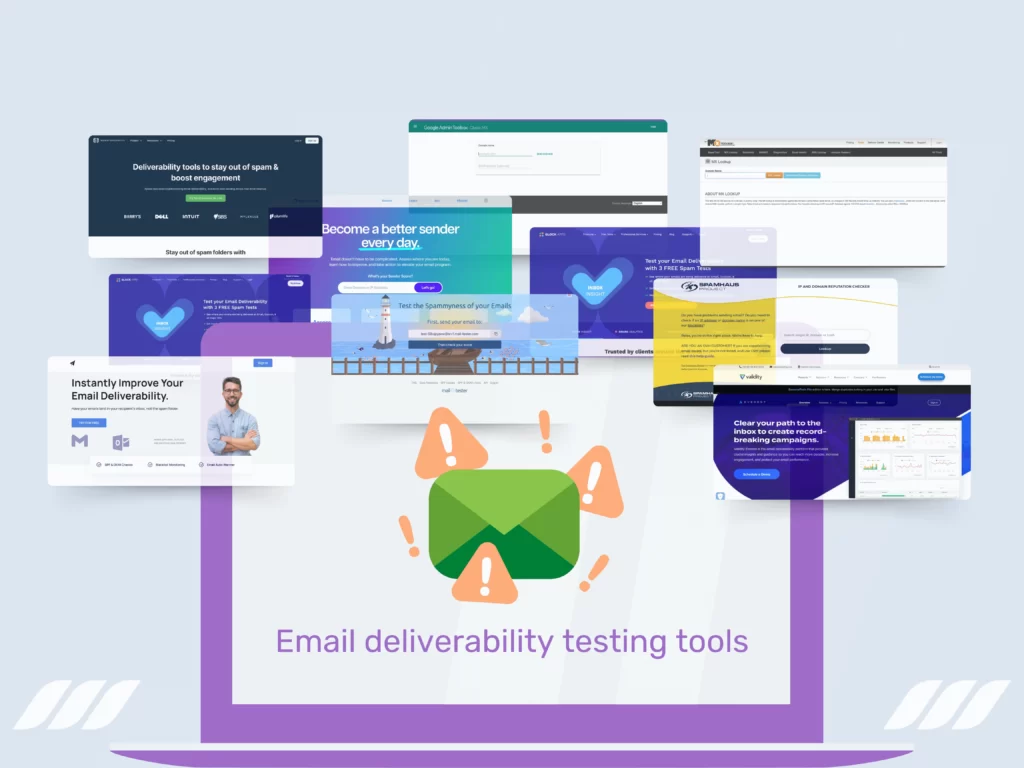
Regularly test your email deliverability using email deliverability testing tools or services. These tools simulate email delivery to various ISPs, identify potential deliverability issues, and provide insights for improvement.
Make sure to monitor key metrics like open rates, click-through rates, bounce rates, and spam complaints to gauge your deliverability performance. Also, use a seed list to send test emails to different email providers and check if they land in the inbox or spam folder, making necessary adjustments to improve deliverability.
8. Maintain List Hygiene
Next, it is good to constantly clean and update your email list to eliminate inaccurate, invalid, and dormant email addresses. By maintaining list hygiene, you can improve the overall health of your email list, reduce the risk of spam complaints, and increase deliverability to engaged subscribers.
Consider implementing processes to remove hard bounces (undeliverable emails) and unsubscribe requests promptly. For instance, you can use an email validation service to identify and remove invalid or risky email addresses from your list, ensuring you only send to active and valid contacts.
9. Monitor Engagement Metrics
Keep an eye on key engagement metrics like open rates, click-through rates, and conversions. Analyzing these metrics will help you identify trends, understand subscriber preferences, and tailor your email content and strategies accordingly. ISPs often consider engagement signals when determining whether to deliver emails to the inbox or spam folder.
For example, you can A/B test your emails’ core elements, such as subject lines, CTAs, message content, or email layout, to find out what resonates best with your subscribers and results in better engagement.
10. Provide Clear Unsubscribe Options
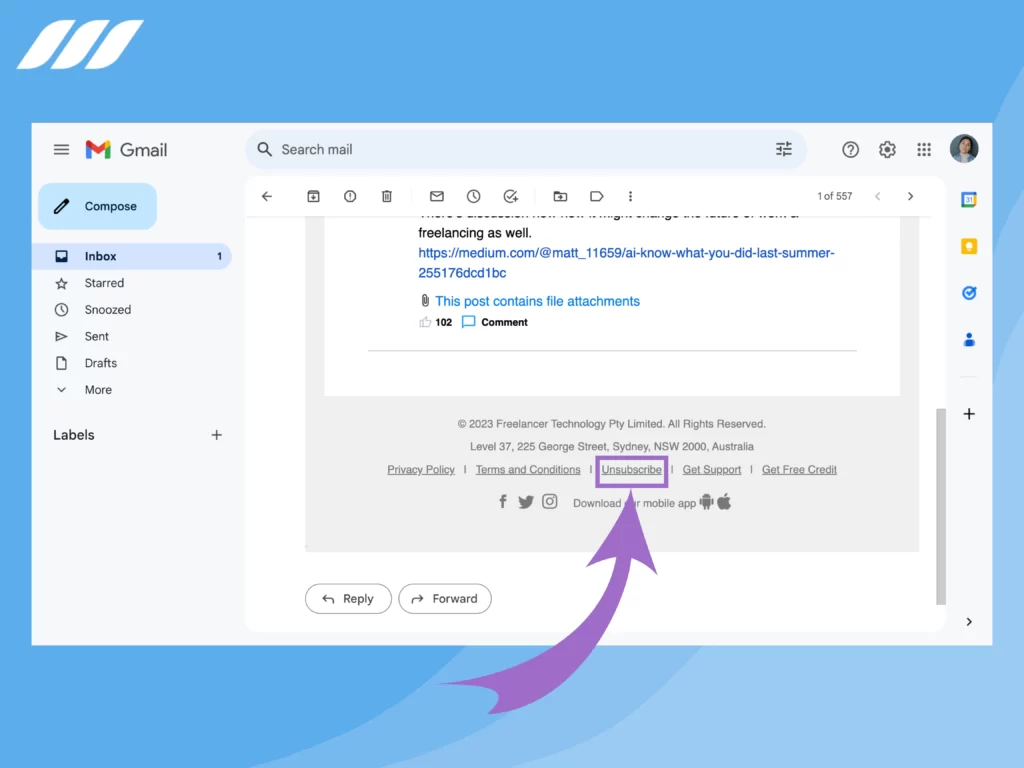
Make it easy for subscribers to unsubscribe from your emails if they no longer wish to receive your communication. You can do this by including a visible and user-friendly unsubscribe link in your emails. Doing so will ensure compliance with anti-spam regulations and also help maintain a healthy sender reputation. Moreover, respecting unsubscribe requests promptly helps build trust with your audience.
11. Tools for Email Deliverability
Take advantage of email deliverability tools that provide insights into your email performance, spam scores, and inbox placement rates. These tools also provide monitoring and diagnostics features to help you identify and address potential issues, keep an eye on your email performance, and make data-driven decisions to improve deliverability.
For example, email testing tools help you preview how your emails will appear across different email clients and devices. And then, there are email delivery monitoring tools that provide real-time monitoring of your email deliverability indicators like bounce rates, inbox placement, and spam complaints.
Read also: Best Email Marketing Automation Tools
6 Ways to Avoid Sending Spam Email
Sending emails that end up in the spam folder is a nightmare for email marketers and professionals. To ensure your messages reach the intended recipients’ inboxes and avoid being marked as spam, it’s crucial to follow best practices and employ effective strategies.
In this section, we’ll explore key ways to avoid sending spam emails and maintain a positive sender reputation.
1. Obtain Permission to Send Emails
Always obtain explicit permission from recipients before adding them to your email list. You can use opt-in forms, checkboxes, or confirmation emails to ensure subscribers willingly agree to receive your emails.
2. Comply With Anti-Spam Laws

Familiarize yourself with anti-spam laws, such as the CAN-SPAM Act and GDPR, and ensure your email campaigns adhere to their guidelines. Also, include accurate sender information, provide an option to unsubscribe, and respect subscribers’ privacy rights.
3. Use a Reputable Email Service Provider (ESP)
Choose a reliable ESP that has established relationships with internet service providers (ISPs) and maintains high deliverability rates. A reliable ESP can help you navigate spam filters and maintain a good sender reputation.
4. Regularly Cleanse and Segment Your Email List
Clean your email list more often to remove inactive, dormant, or bouncing email addresses. Plus, segment your audience based on their interests, past behavior, demographics, preferences, or engagement levels. This will allow you to send targeted and relevant content.
5. Avoid Misleading Subject Lines and Content
Craft subject lines that accurately represent the content of your emails. In addition, avoid deceptive tactics or exaggerated claims, as they can trigger spam filters and lead to a negative subscriber experience.
Also, focus on providing valuable and relevant content that aligns with your subscribers’ expectations, increasing the chances of your emails being perceived as legitimate and desired. You can start an email with the recipient’s name to make it more personalized. What’s more, try to end an email with a professional sign-off statement and signature.
6. Monitor Blacklists and Feedback Loops
It is essential to frequently check if your domain or IP address is listed on email blacklists. Plus, consider using feedback loops provided by ISPs to receive notifications about subscribers marking your emails as spam and promptly address any issues to improve your email deliverability.
Conclusion
As you can see, email deliverability plays a vital role in the success of your email marketing campaigns. Throughout this comprehensive guide, we have explored the best practices for your email campaigns and key elements of email deliverability. From differentiating email delivery and email deliverability to understanding the importance of maintaining a positive sender reputation, we have covered the essentials.
By implementing the ways to improve email deliverability mentioned in this guide, you can significantly enhance your chances of reaching the inbox and engaging your subscribers effectively. And by following the six ways to avoid sending spam emails, you can stay compliant with anti-spam regulations and ensure a positive email experience for your subscribers.

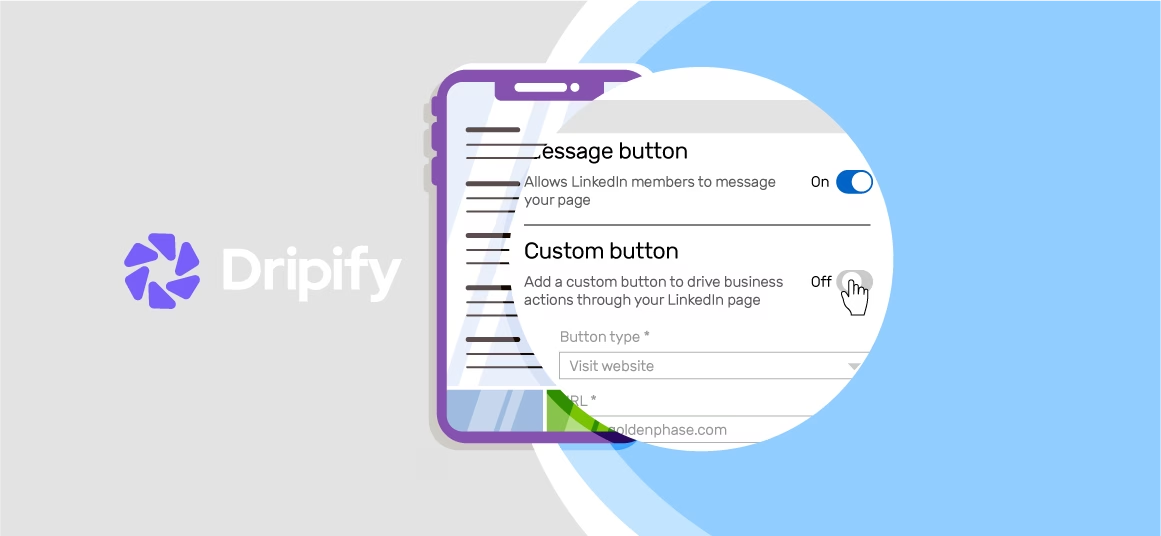
![Email Outreach Tracking [Tips, Tricks and Tools]](https://dripify.io/wp-content/uploads/2025/02/11-7-png.avif)
![Create a Prospecting Plan [+8 Prospecting Methods]](https://dripify.io/wp-content/uploads/2025/02/11-png.avif)